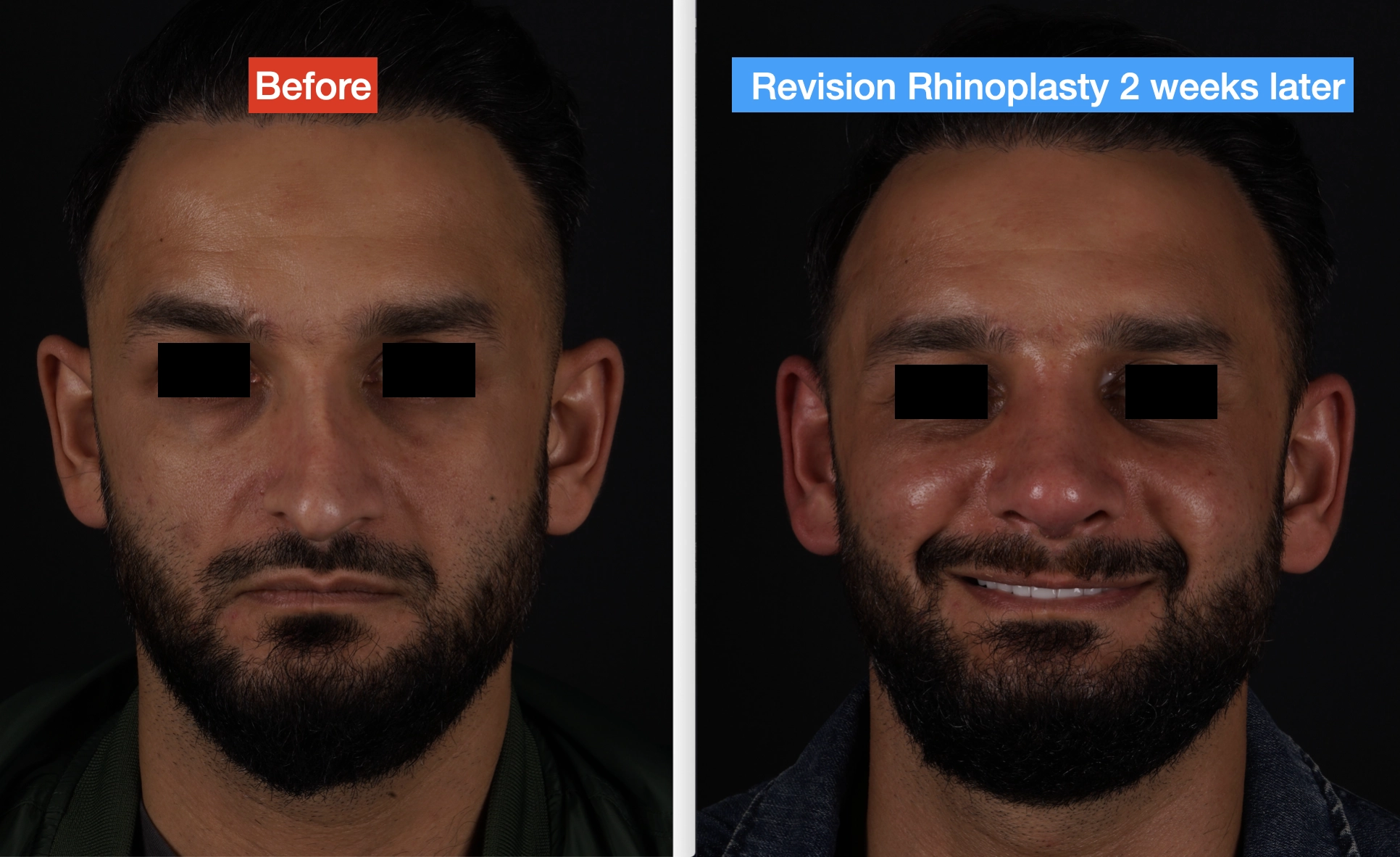Revision Rhinoplasty
Revision rhinoplasty is a surgical procedure to correct or improve the deformities of a previous nose job operation. Generally, It is more complex than the first rhinoplasty, and it requires an experienced surgeon to carry it out better than before results. Revision rhinoplasty is often needed to correct functional or cosmetic issues that were not corrected during the initial surgery or to fix the problems that have arisen due to the before surgery. This article will discuss everything you need to know about revision rhinoplasty, including why it may be necessary, the evaluation process, surgical techniques, recovery, and realistic expectations for results.
Understanding Revision Rhinoplasty and its Purpose
With the influence of social media, nose aesthetic surgeries have become one of the most performed surgical procedures worldwide in recent years. As a result, revision rhinoplasty has also become an important topic . Even in modern times, every surgeon has the possibility of revision, although this rate is slightly higher in nose surgeries. Additionally, the fact that the nose is situated right in the center of the human face can sometimes evoke sensitivity and a sense of deformity in individuals. The reasons for revision rhinoplasty can be attributed to the failure of the initial surgery in some cases, while in other cases, they can occur completely independent of the first surgery due to factors related to the patient’s healing process
If you have undergone a rhinoplasty and are unhappy with the results, it can be frustrating and disheartening. Fortunately, currently medical innovations revision rhinoplasty offers a good solution to address any issues that may have arisen from a previous surgery. In this article, we will discuss the purpose of revision rhinoplasty and what to expect from the procedure.
What is Revision Rhinoplasty?
Revision rhinoplasty is a surgical procedure that involves correcting any issues that may have arisen from a previous rhinoplasty. This can include reshaping the nose, correcting asymmetry, improving breathing, or repairing any damage that may have occurred during the first procedure. Revision rhinoplasty can range from minor adjustments ( Touch up) to more extensive surgery ( Blow Revisons ) , depending on the individual case.
Reasons Why Someone May Need Revision Rhinoplasty
There are several reasons why someone may need revision rhinoplasty. Some common reasons include dissatisfaction with the results of their initial rhinoplasty, the development of breathing problems, or the need to repair damage, after the initial operation, caused by trauma or accidents. But sometimes for very little things dont need to another surgery. It is important to consult with a qualified surgeon to determine if revision rhinoplasty is the right optionor not for you .
Evaluating Your Candidacy for Revision Rhinoplasty
Before undergoing revision rhinoplasty, it is important to evaluate your candidacy for the procedure. This involves consulting with a rhinoplasty specialist and considering any physical or emotional health considerations.

Consulting with a Rhinoplasty Specialist
It is crucial to consult with a qualified rhinoplasty specialist who has experience in revision rhinoplasty. During your consultation, your surgeon will evaluate your nose and discuss your goals and concerns. They may also review your medical history and previous surgical records to determine the best course of action.
Physical and Emotional Health Considerations
Rhinoplasty is a phsycological surgery and sometimes change patient emotions and arise some obsessions too. Before undergoing revision rhinoplasty, it is important to consider any physical and emotional health considerations. This can include ensuring that you are in good overall health and have realistic expectations for the procedure. Your surgeon may advise against surgery if you have certain medical conditions or if they believe that the risks outweigh the benefits.
Preparing for Revision Rhinoplasty: What to Expect
The planning of more detailed revision surgeries, beyond simple revisions, may require more time and patient-physician dialogue compared to the initial surgery. Additionally, the reduction of swelling and the healing process may take a longer time.” Preparing for revision rhinoplasty involves several steps, including the consultation process and preparing for surgery:
The Consultation Process
During the preoperative consultations, your surgeon will be talk your goals and concerns, evaluate your nose, and develop a surgical plan. Your surgeon may also review any previous surgical records and perform imaging tests to assess your nasal structure.
Preparing for Surgery
Before undergoing revision rhinoplasty, you will need to prepare for surgery by following your surgeon’s instructions. This may include stopping smoking, avoiding certain medications and suplement vitamins and some foods ( Green tea, Ginseng, reddish color fruids and vegetables etc), and arranging for someone to drive you home after the procedure.
Different Techniques Used in Revision Rhinoplasty
There are several different techniques used in revision rhinoplasty, depending on the individual case.
Open Rhinoplasty vs Closed Rhinoplasty
Revison rhinoplasty generally performed with open rhinoplasty technique. But some surgeons and with limitedly indications can perform revisions with closed surgery also too. Open rhinoplasty involves making a small incision on the columellar skin of the nose, which allows the surgeon to access the nasal structure more easily. Closed rhinoplasty involves making incisions on the inside of the nose, which results in less scarring. Your surgeon will determine which technique is best for your individual case.
Other Techniques and Considerations
Many revision patients may require cartilage, and sometimes even fascia, for reshaping purposes, as the previous surgery may have utilized the cartilage inside the nose. For this purpose, the most commonly used materials are the patient’s own rib cartilage or cadaver cartilage. However, some surgeons prefer using synthetic cartilage. Your surgeon, who will perform your surgery, will discuss all these recommendations with you in accordance with your preferences. These cartilage grafts will be used for shaping various parts of the nasal tip, bridge, and wings.. Your surgeon will discuss which techniques may be best for your specific case during the consultation process. It is important to have realistic expectations and to follow your surgeon’s post-operative instructions to ensure the best possible outcome.
Risks and Complications Associated with Revision Rhinoplasty
In summary, if a patient is unhappy with their previous surgery and it is causing a significant lack of self-confidence, revision rhinoplasty is a highly successful and low-risk procedure. Revision rhinoplasty is a surgical procedure to correct a previous nose job that did not meet the patient’s expectations. At the same time, this surgery can provide excellent results.

Common Risks and Complications
Infection, bleeding, and breathing difficulties are the very limited and seldomly risks associated with revised rhinoplasty technologies. Patients may also experience swelling, bruising, and discomfort.
More successful results and reduced risks with a Skilled Surgeon
The most effective way to reduce the risks associated with revision rhinoplasty is to choose a skilled and experienced surgeon. A skilled surgeon can help to avoid complications by minimizing incisions and controlling bleeding. A skilled surgeon can also assess the patient’s nasal structure and provide personalized treatment to ensure the best results possible.
Recovery and Post-Operative Care for Revision Rhinoplasty
The recovery period following revision rhinoplasty can vary from patient to patient. It is essential to understand the immediate and long-term recovery considerations to ensure optimal results.
Immediate Recovery Considerations
Immediately following revision rhinoplasty, patients can expect some swelling, bruising, and discomfort. It is essential to follow the surgeon’s instructions for pain management, including any necessary medications and cold compresses. Patients may need to wear a nasal splint or cast for several days to support the nasal structure.

Long Term Recovery Considerations
Long-term recovery from revision rhinoplasty can take several weeks to months. Generally, after the revision rhinoplasy ultimately results can ocur 1-2 years later. It is a surgery that requires patience to achieve these results, and the patient must be psychologically suitable for this process. After Patients should avoid any strenuous activities or exercise for several weeks to allow for proper healing. Proper hygiene and nasal care are crucial during this time, and patients should avoid blowing their nose for at least two weeks after surgery.
Realistic Expectations for Results from Revision Rhinoplasty
Revision rhinoplasty can provide excellent results, but it is essential to have realistic expectations for what is possible.
Understanding What is and is Not Possible
An experienced surgeon will work with the patient to understand their goals for the procedure and assess what is possible. It is essential to understand that not all noses can achieve the same results, and some limitations may exist, such as the thickness of the skin or nasal structure.
Managing Expectations for Optimal Results
Managing expectations is crucial for optimal results. Patients should have a clear understanding of what their nose will look like after surgery and should communicate any concerns or questions with their surgeon. Additionally, patients should commit to proper follow-up care to ensure a successful recovery.In conclusion, revision rhinoplasty can be a highly effective solution for individuals who are not satisfied with the results of their initial rhinoplasty surgery. It is important to carefully evaluate your candidacy for the procedure, choose an experienced surgeon, and have realistic expectations for the results. By following these guidelines and taking the necessary steps to prepare for surgery and recovery, patients can achieve the optimal outcomes they desire from their revision rhinoplasty procedure.
Frequently Asked Questions
The waiting period between the primary rhinoplasty surgery and revision rhinoplasty varies depending on the individual case. It is recommended to wait at least 4-6 month after the initial surgery to allow for complete healing before considering revision surgery. But, if the revision of the patient, specifically the second revision, is involved, it is recommended by many authors to plan the surgery at least 1 year later.
Revision rhinoplasty can be more complex and involved than primary rhinoplasty, but normally have some pain or discompfortable like primary rhinoplasties . However, the level of pain and discomfort varies from person to person and depends on the extent of the revision.
In most cases, revision rhinoplasty is considered a cosmetic procedure and is not covered by insurance. However, if the procedure is deemed medically necessary to correct a functional issue, such as breathing difficulties, insurance may cover a portion of the cost.
In rare cases, a third or multiple revision rhinoplasty surgery may be necessary to achieve the desired results. However, sometimes the patient’s tissues may no longer withstand another revision surgery and can pose risks such as necrosis. At this point, accepting the situation as it is and not considering a new surgery may be a more appropriate decision. It is important to have realistic expectations and to work closely with your surgeon to ensure that the best possible results are achieved with each procedure.













